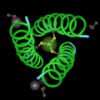For many years, I've been perfectly content to work with small numbers of things. Working with one gene or one protein is great. Even small groups of genes are okay. I'm fine with alternatively spliced genes with multiple transcripts, or multiple polymorphisms, or genes in multi-gene families, or groups of genes in operons.
But I never trusted microarrays.
First, there were all the articles questioning the ability to reproduce microarray data. For many years, people reported difficulties in reproducing experiments, especially if they used chips from different manufacturers or different analysis techniques (1).
Second there were the lab stories. I remember one story about a group finding all kinds of exciting things only to discover later that all those genes they found were turned on because the samples were put in an ice bucket at the wrong time.
There have been concerted efforts during the past few years, particularly by the MAQC group, to standardize microarray experiments and make the result more reproducible.
But still, those stories were a handy excuse to avoid microarrays as much as possible.
Then Next Generation DNA Sequencing (NGS) came along. It turned out that many of the data analysis techniques developed for microarrays were useful for analyzing Next Gen data. I couldn't avoid them anymore.
It was time to bite the bullet and learn about microarrays.
References:
1. Shi et. al. 2008. The balance of reproducibility, sensitivity, and specificity of lists of
differentially expressed genes in microarray studies. BMC Bioinformatics 2008, 9(Suppl 9):S10

What, in your opinion, was the best review paper of these microarray analysis techniques that you read during this reading? I guess many readers might be interested...
thanks
I'll post some of the articles over the next month. For starters, take a look at the article that I referenced. I thought that one was pretty good.
Based on my experience, NGS is really a valuable and reliable techonoglogy for quantification of gene expression.
I guess many readers might be interested...